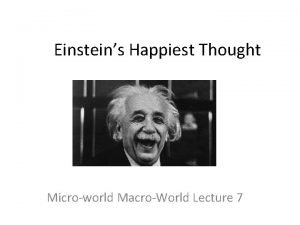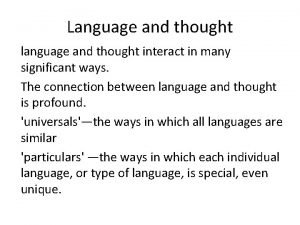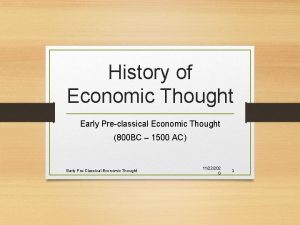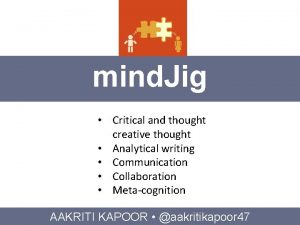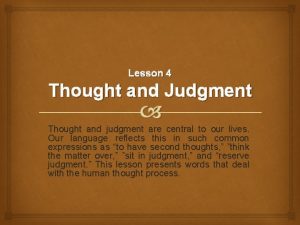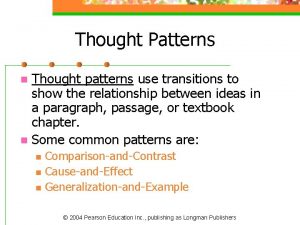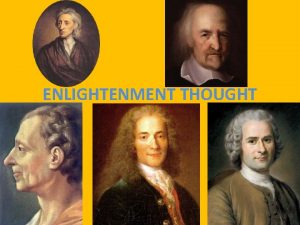The happiest thought in my life The happiest




















- Slides: 20

The happiest thought in my life

The happiest thought in my life The general theory of relativity began with a sudden thought. It was late 1907, two years after the "miracle year" in which Albert Einstein had produced his special theory of relativity and his theory of light quanta, but he was still an examiner in the Swiss patent office. The physics world had not yet caught up with his genius. While sitting in his office in Bern, a thought "startled" him, he recalled: "If a person falls freely, he will not feel his own weight. " He would later call it "the happiest thought in my life. "

Falling or floating ? Einstein soon refined his thought experiment so that the falling man was in an enclosed chamber, such as an elevator, in free fall. In the chamber, he would feel weightless. If he dropped an object, it would float alongside him just as if he floated in outer space, far from any planets. There would be no way for the man to tell - no experiment he could do - to determine if the chamber was falling at an accelerated rate or it was floating in a gravity-free region of outer space. FALLING FLOATING

Falling or floating? If an elevator is falling freely toward the ground because of gravity, an occupant inside will feel weightless just as if the elevator was far away from any planet, moon, or star. No experiment would help you distinguish between being weightless far out in space and being in free-fall in a gravitational field. Locally freely falling towards the Earth is equivalent to being at rest with respect to the distant stars far from any gravitating body.

Gravity and acceleration Then Einstein imagined that the man was in the space where there was no perceptible gravity, and a constant force was pulling the chamber up at an accelerated rate. He would feel his feet pressed to the floor. If he dropped an object, it would fall to the floor at an accelerated rate just as if he stood on Earth. There was no way for the man - to make a distinction between the effects of gravity and the effects of being accelerated. GRAVITY ACCELERATION

Gravity and acceleration If you drop a ball in an elevator at rest on the Earth, the ball will accelerate toward the floor with an acceleration of of 9. 8 meters/second 2 just as if you drop the ball in an upward accelerating elevator far out in space. The ball will also accelerate toward the floor at 9. 8 meters/second 2 No experiment would help you distinguish between being at rest on the Earth or being in a upward accelerating elevator far out in space. Locally being at rest on the Earth's surface is equivalent to being in a uniformly accelerated spaceship.

Principle of equivalence The local effects of gravity and of acceleration are equivalent.

Gravitational mass and inertial mass “ We remember that the acceleration of a falling body is quite independent of its mass and that it was this fact which revealed the equality of gravitational and inertial mass (p. 37). We also remember that the equality of the two masses, gravitational and inertial, was quite accidental from the point of view of classical mechanics and played no role in its structure. Here, however, this equality reflected in the equal acceleration of all falling bodies is essential and forms the basis of our whole argument. ” Evolution of physics, page 227

As a result…………. .

The neglected clue

The very importance of the neglected clue The principle of equivalence is based on the «neglected clue» i. e. the equality between the inertial mass of a body (its resistance to being accelerated by a force) and the gravitational mass of the body ( a measure of the attitude of a body to attract or to be attracted by other bodies) Mass and inertia (Khan Academy) https: //www. youtube. com/watch? v=f. FFg. Wl 6 t-6 c https: //www. youtube. com/watch? v=Q 1 Hw. Eh 5 PCIw

Are we sure?

Let’s talk Einstein Evolution of phyisics page 36 «The readiness with which a body responds to the call of an external force depends on its inertial mass. Now the Earth attracts a stone with the force of gravity and knows nothing about its inertial mass. The «calling» force of the Earth depends on the garvitational mass. The «answering» motion of the stone depends on the inertial mass. Since the «answering» motion is always the same – all bodies fall from the same height fall in the same way- it must be deduced that gravitational mass is equal to inertial mass. »

FALLING AND FLOATING no esercizio • Imagine waking up in a box, completely weightless. • Are you falling toward Earth or floating in outer space? • Einstein realized that falling freely in gravity feels the same as floating in space with no gravity. • Gravity seems to be absent in free fall, at least in the small area around you. • Since floating in space and falling in gravity feel the same, Einstein reasoned there must be no “force” of gravity at work in either state.

GRAVITY AND ACCELERATION ( no esercizio ) • Now imagine waking up on the floor of the box. • Are you resting on Earth or accelerating in a spaceship? • Einstein also realized that resting in gravity feels the same as accelerating at 1 g. • Since acceleration and gravity feel the same, he argued that they must have the same cause. • Einstein proposed that the massive objects like the Earth curve space and time, and that we call gravity arises from this curvature. • Acceleration feels the same as resting in a region of curved space and time.

Why? ? ? ? Why would this be true? The answer can be traced back to the way in which gravity affects bodies. Remember that the quantity we called m (the mass) played two different roles in Newton's equations. One is to determine, given a force, what the acceleration of the body would be: F = m a (the inertial mass). The other is to determine the intensity with which the said body experiences a gravitational force: F = m M G / r 2 (the gravitational mass). As mentioned before these two quantities need not be equal: the first ``job'' of m is to tell a body how much to accelerate given any force, a kick, an electric force (should the body be charged), etc. The second ``job'' tells the body how much of the gravitational force should it experience and also determines how strong a gravitational force it generates. But, in fact, both numbers are equal (to a precision of ten parts per billion).

Nota bene • This is reminiscent of Galileo's argument: the observer lets go of some objects which remain in a state of uniform motion (with respect to him!). This behavior is independent of their chemical or physical nature (as above, air resistance is ignored).


FORSE DA TOGLIERE • https: //www. youtube. com/watch? v=Vl 6 Mrhgum 2 c • How mass and garvity woork in the space samantha cristofoloetti • https: //www. youtube. com/watch? v=P 36 xhtpw 0 Lg

Let’s Einstein talk ( Evolution of phyisics page 36) NON METTERLO
 Einstein happiest thought
Einstein happiest thought The happiest moments of my life
The happiest moments of my life Incomplete thoughts
Incomplete thoughts Happy最高級
Happy最高級 Happiest spelling
Happiest spelling Hát kết hợp bộ gõ cơ thể
Hát kết hợp bộ gõ cơ thể Lp html
Lp html Bổ thể
Bổ thể Tỉ lệ cơ thể trẻ em
Tỉ lệ cơ thể trẻ em Voi kéo gỗ như thế nào
Voi kéo gỗ như thế nào Thang điểm glasgow
Thang điểm glasgow Hát lên người ơi
Hát lên người ơi Môn thể thao bắt đầu bằng chữ đua
Môn thể thao bắt đầu bằng chữ đua Thế nào là hệ số cao nhất
Thế nào là hệ số cao nhất Các châu lục và đại dương trên thế giới
Các châu lục và đại dương trên thế giới Cong thức tính động năng
Cong thức tính động năng Trời xanh đây là của chúng ta thể thơ
Trời xanh đây là của chúng ta thể thơ Mật thư anh em như thể tay chân
Mật thư anh em như thể tay chân Phép trừ bù
Phép trừ bù độ dài liên kết
độ dài liên kết Các châu lục và đại dương trên thế giới
Các châu lục và đại dương trên thế giới
